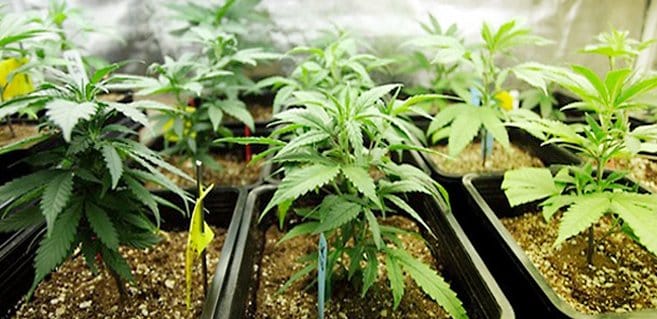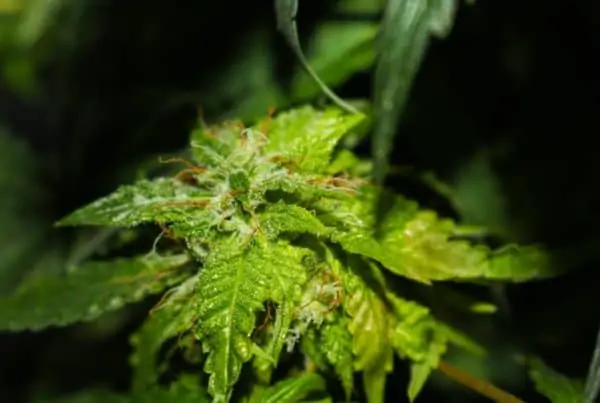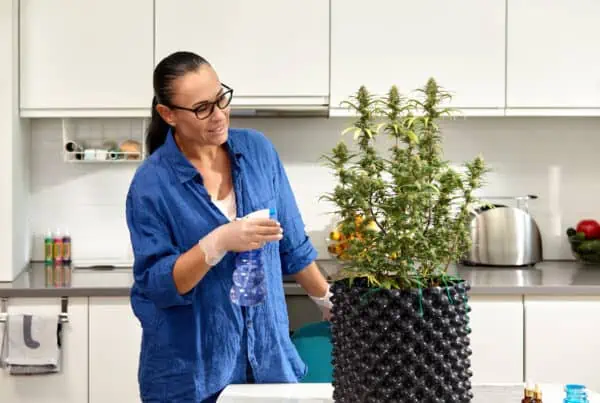TABLE OF CONTENTS
Hydroponics is a method of growing using nutrient solutions in water, without the use of soil.
Many cannabis growers choose hydroponic systems as their way to grow cannabis indoors.
There is nothing new about hydroponic growing and the practice has a long history, so this method is not exactly modern, just less common among home cultivators.
A Definition of Growing Hydroponic Cannabis
The process of hydroponic cultivation is growing plants in nutrient solutions, usually with an inert medium like coco coir or gravel to provide support.
Although some sort of medium is usually used, plants can actually grow straight into the nutrient-rich water, with only the roots submerged.
Growing this way makes it easy to evaluate water quality and make nutritional adjustments quickly if needed. There are a variety of nutrients on the market, including organic solutions, that are appropriate for growing hydroponic cannabis and were designed specifically for this purpose.
Like some soil nutrients, some hydroponic nutrients have additives that automatically adjust water pH, making meter readings and adjustments unnecessary.
The legal cannabis industry is divided when it comes to which method to use for the best products and highest profits, but both growing methods are alive and well on the commercial level.
Since growing is possible year-round indoors and hydroponic growing is an indoor endeavor the vast majority of the time, indoor commercial cannabis growing will probably see an increase in hydroponic use.
Soil growing is more flexible and can easily occur either outdoors or indoors, so the use of soil is probably more widespread overall when it comes to commercial cultivation.
Here we give you a look at seven hydroponic grow systems that will help you maximize yield.
1. Ebb & Flow
Also referred to as flood and drain, ebb and flow is a popular form of hydroponics because it is easy to use, reliable and forgiving. Ebb and flow systems use an inert medium to anchor the roots and support the plants.
The plants receive water and required nutrients from an aerated hydroponic solution, which alternately floods then drains from the plants.
There are two types of ebb and flow hydroponic systems:
- Flood to waste
- Closed loop recirculating
Ebb and flow systems are very flexible, generally low-cost and have few practical drawbacks.
Three recommended ebb and flow systems:
- Active Aqua’s Grow Flow Ebb & Flow System
- Sentinel MEF-EXP Modular Ebb & Flow System 6 Site Expansion
- Flo-n-Gro Tsunami 5 Gallon Ebb & Flow 6 Site System
2. Aeroponics
Aeroponic systems rely on an air or mist environment without the use of soil or a medium. This type of grow system is not very forgiving and must be monitored closely.
Normally closed cell foam or similar product is compressed around the lower stem to support the plant during growth, additional support such as a trellis may also be used to support the growing plants.
Because of the sensitivity of plant root systems, aeroponics is often combined with conventional hydroponics as an emergency backup nutrition and water supply for if the aeroponics system fails.
Two recommended aeroponic systems for cannabis growing are:
- Aeroflo Unit Aeroponics System (18, 20, 30, 36, 60)
- C.A.P. Aeroponic Eight System
4. Gravity System
This is a very simple hydroponic growing system where the nutrient enriched water system is placed higher than the plants and the water is allowed to flow to the plants by gravity alone and drains to waste or to a catch system for reuse.
This type of hydroponic irrigation system does not need electrical power or pumps, but relies on rather manually or naturally placing the nutrient enriched water reservoir higher than the plants.
5. Capillary Mats
This type of hydroponic system most often uses a fibrous mat suspended over a nutrient rich reservoir with a strip of the mat or a wick extending down into the water to draw nutrient-rich water up into the plants. The plants can also sit on top of the mat or use a wick system to draw the nutrient water up into the plants root system.
This too is a very simple manual system that needs no external power sources, so it's great for beginners to hydroponics.
6. Deep Water Culture (DWC)
In this type of hydroponic system the plants are suspended over an aerated nutrient rich reservoir with the roots hanging down into the water to draw up needed nutrients.
DWC systems are ideal for beginners in hydroponics.
For water culture systems we recommend looking into products from Current Culture H2O.
Learn to Setup a Hydroponic System
We recommend you look into hydroponic gardening if you are interested in growing weed and want to know how to get the best yields from your plants.
Although most beginning marijuana growers choose soil for its ease of use and low entry cost, they usually switch to some type of hydroponic method as they get more comfortable with the process of growing marijuana indoors.
Lighting
There are many grow-light options, and the best lighting choice largely depends on the size of the garden. High-intensity discharge (HID) usually in the form of high-pressure sodium or metal halide, compact fluorescent lights (CFL), and light-emitting diode (LED) will all grow cannabis just fine, depending on the grower’s preference and needs.
Grow Table
This important and large piece of equipment will take up much of your growing space. The function of the table and its tray is to contain and return excess water to the reservoir. The table will have a low point where water collects and travels back to the reservoir before circulating back to the plants again.
pH and PPM Meters
Growing hydroponically—or with soil—requires evaluating the water source used and making adjustments if necessary. Water adjustments may prove necessary with pH boosters and reducers.
Nutrients
Hydroponic nutrients are available in liquid and powder form. The majority of cannabis growers prefer organically grown flower, so organic nutrients are the best choice. Bottled nutrients are the easiest to use. There are organic options available—or as close as you can get to organic out of a bottle.
Support Media
Although the plants are fed directly from the circulating water, a medium is necessary to provide mechanical support of the plants. A variety of substances are commonly used, including coco coir, gravel, and clay pellets. Rock wool cubes make a good starting foundation for young plants when they first go into the system.
Net Pots
Depending on the scope of the cultivation project, a range of pot sizes will work. Something in the 2- to 7-gallon range should suit your needs.
Reservoir
This reservoir tank holds the water that circulates through the hydroponic grow system. The size of the tank depends on the size of the grow.
Air Pump and Air Stone
The air pump should always be running to guarantee the water is agitated and well oxygenated. You want the water to be oxygenated and moving.
“
There are over 300,000 jobs in the cannabis industry. CTU trained me for one of them!

Makes $24.50 @ THC +
Water Pump
The pump drives the water circulating through the system, so you want to make sure it’s high quality. Again, the appropriate pump largely depends on the number of plants grown. Generally speaking, the larger the size of the pump, the better.
Tubing
Usually constructed of plastic, tubing will be necessary to keep water circulating throughout the system, moving it between the reservoir and the plants. The plastic tubing will eventually have holes drilled into it and serve as a drip line.
Drip Line Emitters
You will want at least one drip-line emitter per plant.
Hydroponic Grow Systems Conclusion
CTU has used all types of methods for growing cannabis and over the years has found the greatest results as far as yield and quick harvest times with hydroponics instead of soil.
Although some people who grow marijuana prefer soil because it produces a better tasting bud and a better smoke, we advise anyone looking for large yields and quick turnarounds to consider growing hydroponically.
For more information on these types of hydroponic systems and to learn insider secrets from industry-recognized growers, enroll in CTU today, the leader in marijuana growing classes.

Luis Cordova
Luis Cordova is a distinguished author, and renowned expert in cannabis cultivation, who possesses a Master's degree in Plant Biotechnology and Pharmaceutical Science. As a valued contributor to highly esteemed publications such as Cannabis Training University and Maximum Yield Magazine, Luis has emerged as a trusted source of guidance and knowledge in the cannabis industry. Having written thousands of informative articles, Luis is widely recognized for his comprehensive expertise on cultivating cannabis, both indoors and outdoors.












 Jeff was involved in an accident where he endured a traumatic brain injury. He had a week-long stay in ICU where brain surgeons
Jeff was involved in an accident where he endured a traumatic brain injury. He had a week-long stay in ICU where brain surgeons  100% risk free money back guarantee within 48 hours after purchase if student has not completed any of the courses or exams.
100% risk free money back guarantee within 48 hours after purchase if student has not completed any of the courses or exams.